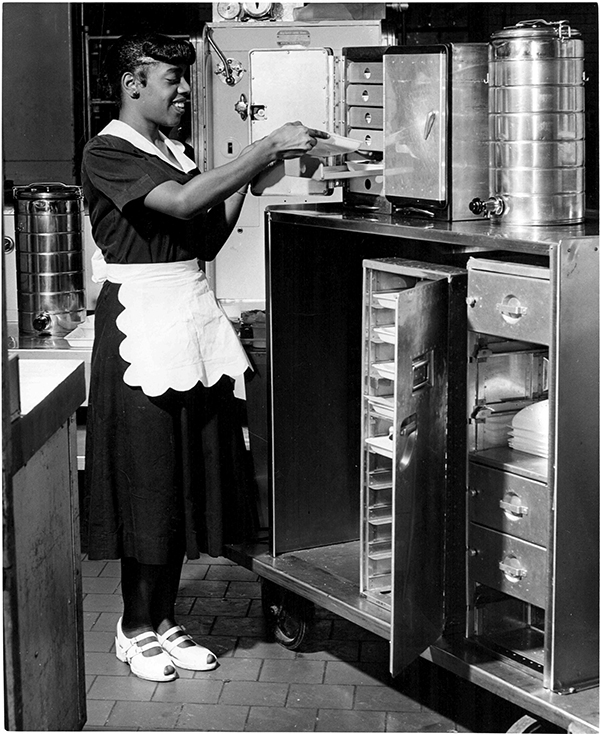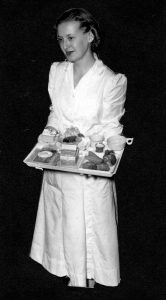
Marian Sizelove and Joyce Gibbons, dieticians at Barnes Hospital, wrote in 1949 that “One of the age old complaints of hospital patients is that the hot foods [they are served] are not hot and that the cold foods are not cold.” Frank Bradley, director of Barnes Hospital from 1939-1962, worked with the hospital dieticians to improve the quality of patient food served at Barnes Hospital by drawing inspiration from a surprising source – the airline industry, which had been serving in-flight meals since 1929. In implementing a model of food service based on the airlines’ method, Bradley and Barnes Hospital caused a minor sensation in the world of hospital administration.
In the June 1950 issue of the journal Hospitals, Bradley published an article detailing the new food service model being used at Barnes Hospital. In the old model, food was prepared in a central kitchen at Barnes and then sent in bulk to be assembled on patient trays in pantries on each floor of the hospital. The food’s long journey from the kitchen to the floor pantries, and the time spent assembling it on trays there, led to lukewarm and unappetizing meals being presented to patients.

In the new, airline-based model, Barnes Hospital employees called “pantry maids” wheeled specially designed carts to each floor. The carts carried a tray for each patient, with the patient’s cold food selections already assembled on the tray in the main hospital kitchen. These trays with cold food were loaded into a specially constructed carrier on the cart which was cooled by dry ice, keeping the cold food cold. The patient’s hot food selections were kept hot by being stored separately from the cold food trays, in an electronically heated and insulated oven attached to the cart. When the pantry maids reached the patient’s floor, the hot food selections were quickly added to the patient’s tray with the cold foods, and the trays were then presented to the patient. Insulated beverage jugs for hot and cold drinks also fit on the cart, and cutlery and other accouterments were stored in drawers on the cart for quick access.

The level of interest generated by Frank Bradley’s article on the airline food service model was such that within a month of its publication, the article’s publisher had to create a form letter to send in response to the many interested parties writing them to ask for more information. Bradley’s files include letters from hospital administrators and dieticians across the country and in Canada, asking for more information on the new food service method. Architects of hospitals yet to be built wrote asking about the building specifications that might be needed to facilitate implementing the airline food service model in their new hospitals. The United States Army sent a team of dieticians to observe the new service model in action and later implemented it on a trial basis in one of their own hospitals. A salt company that sold individual salt packets reprinted Bradley’s article and sent it with samples of their product to potential customers, pointing out that their packets would be perfect to add to patients’ trays when they were assembled off the cart in the new airline food service method. A company that manufactured meal carts for the airline industry contacted Barnes for advice as they began selling their products to the hospital industry as well.
Bradley believed Barnes Hospital was the first in the country to adapt the airline food service method, and the American Hospital Association agreed saying, “this is the only experiment in airline food service that we have heard about.” Along with its other medical milestones, Barnes Hospital can count this unusual achievement among its “firsts”– it was one of the first hospitals in the country to adapt the airline style of food service to a hospital environment.
